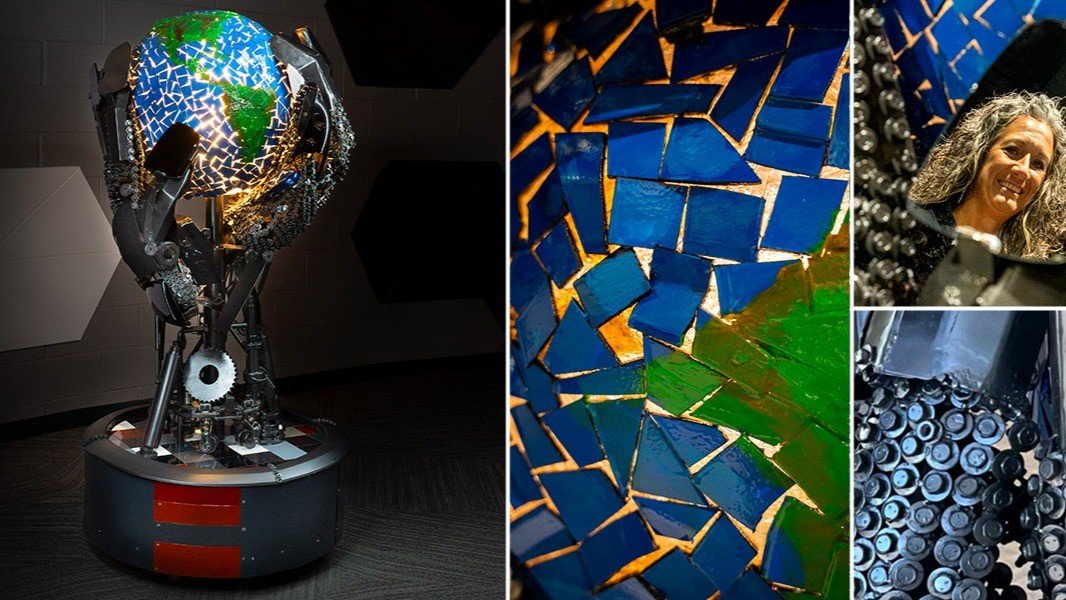
In her sculpture titled “Car(ing) for Tomorrow, Today,” artist Kristy Burns fuses creativity with corporate responsibility
Scrapped or damaged bolts, mirrors, metal, fenders and other discarded car parts aren’t the first things you’d normally look for to tell a story about sustainability.
But that’s exactly what artist Kristy Burns used to create a sculpture titled “Car(ing) for Tomorrow, Today.” Commissioned by Nissan’s sustainability team in the U.S., the sculpture represents Nissan’s commitment to advancing responsible manufacturing, environmental stewardship and social responsibility.
“I created this piece to support an overarching idea of sustainability,” said Kristy. “Reusing and recycling are just the beginning of efforts needed for our future and world. Miscellaneous used, damaged or deformed objects can be given new life through repurposing and recycling – combining into beauty.”
“Car(ing) for Tomorrow, Today” is composted of damaged or recycled parts from Nissan’s Vehicle Assembly Plant in Smyrna, Tennessee. Kristy walked through the plant looking for parts. She brought several boxes home, placed them in the living room of her 700-sq-ft apartment-turned-art-studio and quickly realized her first challenge: space.
Kristy has created murals, graphic wraps and large fiberglass statues in her living area before. Creating a piece with car parts, some large and very heavy, was a new challenge.
“Welding doesn’t mix well with area rugs,” said Kristy. “I ended up using my neighbor’s garage.”
The next challenge was a vision. Settling on “caring for the world,” she decided to make a globe the focal point. She made a sphere out of scrap fiberglass pieces surrounding a large exercise ball. Using four plastic body panels, she cut the material into small four-sided pieces and began to sand each piece by hand to create build earth.
“I wanted to color the world,” said Kristy.
She painted the pieces blue for oceans and green for land symbolizing a clean and beautiful world. She used hot glue to apply the pieces to the fiberglass sphere creating a beautiful mosaic.
“The globe is held up by strong hands expressing equality and the desire to make the world a safer place,” Kristy said. “On the left is the female hand, marked by the fingernails derived from Nissan Rogue mirrors. On the right is the larger male hand with fingers comprised of sturdy scrap metal.”

Connecting the hands presented Kristy with her next challenge. Her idea was to fuse over 1,000 bolts and washers to form the fingers in each hand. While her two-year degree in graphic design didn’t have a welding component to it, she had plenty of practical experience in her father’s workshop growing up.
“My dad and I used to rebuild old pickups,” said Kristy. “We broke them down to the frames and then put them back together.”
Even with this experience, welding different thicknesses of small metal parts presented Kristy’s biggest challenge.
“From thin rolled metal paint samples to bolts with washers, up to a deformed rotor, I could only tack weld,” said Kristy. “With a million little welds it’s quite sturdy, but with pressure in the wrong area, one failed weld can crumble a whole hand.”
With two giant hands holding a globe completed, finishing details include a light inside the globe, casters from carts in the plant to move the finished sculpture, and multiple paint line color chips lining the base to represent diversity.
For Kristy, the finished piece represents the ability to maintain life with the resources currently available, while keeping the future in mind. She says people can make a difference by studying, learning more and caring as best as we can in the present for what we have today.

“Kristy’s beautiful sculpture reflects Nissan’s commitment to a cleaner, safer and more inclusive world,” said
Candy Listz
, manager of sustainability in the Americas for Nissan. “Showcasing the beauty of repurposing, Kristy’s art symbolizes the harmony between responsible manufacturing and care for the environment. We hope people seeing it will pause and think about how they can make a positive impact in society and the world.”
Nissan Green Program 2030
NGP2030 identifies climate change, resource dependency, air quality and water as key material priorities to address. Nissan strives to adapt to a scenario limiting global temperature increase to 1.5 degrees Celsius or less to move toward carbon neutrality, transitioning to a circular economy, and minimizing dependence and impact on nature and ecosystems.
Nissan Social Program 2030
NSP2030 is a comprehensive action plan and an enhanced continuation of Nissan’s social initiatives, serving as a foundation of The Arc and contributing to achieving Nissan Ambition 2030. With a people-centric approach, Nissan is committed to growing together with its employees, communities, partners and broader society. This holistic approach will help the company make a positive impact on society, become a truly sustainable business and create a better world for future generations.









